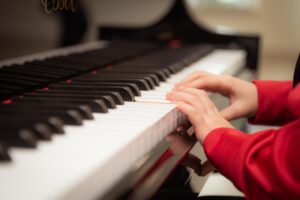Using play-along sheet music in group activities (e.g., Solfeg.io)
A longer activity involving two (or more) teachers for groups of 20-25 students, using the app Solfeg.io or a similar app in music instruction. This activity could run over 6 weeks, a semester, or a full year. Teachers use the app for exercises and for visualizing sheet music and showing songs on a big screen using a projector or smartboard.
Navigate the different aspects of the activity here

The purpose of the activity
- To support and sustain students’ motivation for playing music e.g. through access to contemporary music and a wide variety of genres available in the app
- To encourage students to learn one or more instruments
- To support rhythm learning through rhythm and movement exercises
- To expand students’ music knowledge through quizzes
- To aid classroom management in larger groups
Target audience
Music students (introductory level)

Technology/setup
- Access to the app Solfeg.io or a similar app, considering:
- Subscription/package options
- Cost and educational discounts for multiple licenses
- Suitability for the activity, group size and organizational needs
- Large screen, projector, or smartboard for displaying the app for the entire group, and speakers to connect to a tablet or computer for sound
- Tablets with the app for students, displaying sheet music and/or songs; headphones may also be used, so students can alternate between focusing on their instrument or voice individually and group harmony
- A tablet or computer for the teacher to display the app on the big screen
- Access to a range of instruments (e.g., guitar, bass, ukulele, keyboard, and vocal parts) so the entire group or most of the group can play an instrument, or students may bring their own
- A large enough room to accommodate working with multiple instruments
Requirements
Teacher
- Familiarity with or curios to learn the app and explore its exercises, songs, and features
- Knowledge of the instruments being taught
- Willingness to use an app in music teaching
Student
- Interest in playing instruments and singing with others
Before, during and after the activity
BEFORE
The teacher
- Prepare the piece/song
- Plan the instruction for the selected/available instruments and vocal parts
- Prepare the room by tuning instruments and arranging instrument groups throughout the room
- Optionally, provide chord printouts for visual learning as a supplement to tablets
DURING
Adjusted according to students’ level
The teacher
- Begin with warm-up activities from the app, such as dance exercises, rhythm games, or quizzes
- Introduce the piece/song and divide students into instrument and vocal groups, or other relevant groups based on the context
- Move around the room, guiding the instrument and vocal groups, encouraging students to help one another
- Conduct the first group playthrough of the piece/song
- Rotate students to a new group, e.g., a different instrument/vocal part or level of skill required
- Move around the room again to guide groups, encouraging peer support
- Lead a second group playthrough of the piece/song
The students
- Follow along on the big screen
- Focus on one instrument or vocal part at a time
- Optionally sing along if relevant and manageable alongside the instrument
AFTER
The teacher
- Pack up the instruments
- Collect tablets and power down other screens
- Restore the room

Experiences with the activity
Two teachers from Aalborg School of the Arts conducted an 8-week activity (6 sessions) with a 5th-grade class. Students reported that the activity was “fun” and that playing various instruments added to the enjoyment. One student shared, “I thought it was fun to play instruments each time”, while another noted they appreciated the rotation between instruments, saying it “made it more fun”. Students found some instruments more challenging than others. They also observed that the big screen enhanced the experience, with one student saying, “I thought it was well taught. The big screen with the bar showing when to play and sing was helpful”. Another student added, “I think more people followed along on the screen than when an adult does it”.
The warm-up exercises were well-received, and one student mentioned it was great to start with stomping and clapping because “it got you moving, …otherwise we usually just sit in our chairs during music time”. Students also commented positively on the song choices, with one noting, “I was surprised by the songs. They were actually good music”, and another adding, “sometimes I even played the song on my own after class”.
The teachers observed high engagement among the students, noting that “they knew the song before we started, which led to a great response, and the students sang along regardless of which instrument they were playing—super cool!”. They found that “the screen helps maintain students’ focus, and although some instrument parts can be challenging, students remain engaged through the visual cues”. Some challenges with the app and the chosen subscription package did arise, with teachers noting it was easy to get caught up evaluating the platform itself due to minor issues. They also pointed to a “dilemma between playing as a band with varied instruments versus everyone playing guitar”. Overall, one teacher concluded, “I think the active participation—having them play instruments—was really effective. Making it approachable on the instruments was crucial for them”.
Guitar, ukulele, and bass teachers Dennis Otte Nielsen and Casper Brændstrup at Aalborg School of the Arts have completed an 8-week course using the Solfeg.io app with a 5th-grade class.

